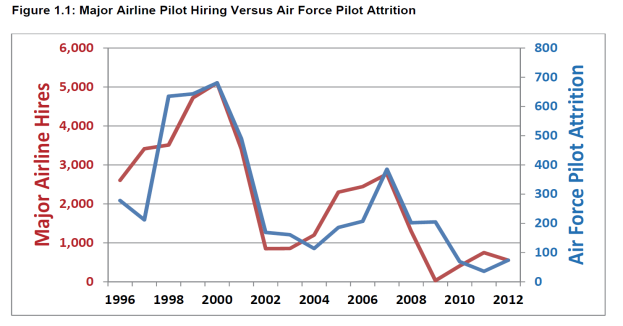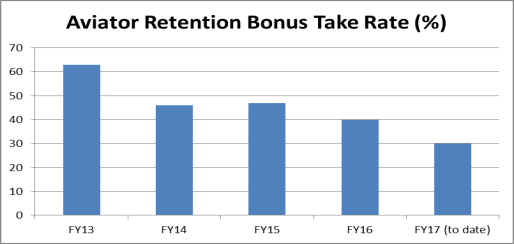In his opening comments to the 2017 U.S. Air Force Posture Hearing before the Senate Armed Services Committee, Chairman John McCain stated, "The force is short 1,500 pilots.... This is a full-blown crisis, and if left unresolved, it will call into question the Air Force's ability to accomplish its mission." According to current Air Force statistics, the service is 1,947 pilots short of its authorized strength. The shortage is most acute among fighter pilots: the Air Force predicts it will be 1,055 fighter pilots short of 3,781 authorized by the end of FY2017, following a deficiency of 873 in FY2016. Commenting on the shortage, the Air Force Chief of Staff, General David Goldfein, warns, "The Air Force is as busy as we have ever been, but we are also smaller than we have ever been. Consequently, we have less margin for error when it comes to filling our cockpits."
Analysts point to a number of factors driving the Air Force pilot shortage, chief among them an increase in demand for commercial airline pilots. Figure 1 illustrates the historical correlation between airline hiring and Air Force pilot attrition, which creates concern that the shortage will grow given predictions for sustained industry growth.
|
Figure 1. Major Airline Hires vs. Air Force Pilot Attrition
|
 |
|
Source: Nolan J. Sweeney, "Predicting Active Duty Air Force Pilot Attrition," RAND, 2015.
Notes: The left vertical axis with corresponding red line depicts pilots hired by the seven major airlines (Alaska, American, Delta, FedEx, Southwest, United, and UPS). The right vertical axis with corresponding blue line shows Air Force pilots leaving the service.
|
Generally, analysts point to three causes for the uptick in airline hires:
- A large percentage of airline pilots will hit the mandatory retirement age of 65 (14 C.F.R. §121.383) in the next 10 years. One recent study forecasts 36% of the workforce will retire by 2026, while another estimates as high as 42%.
- The airline industry has grown steadily in the past five years, and studies forecast further increases in response to growing passenger demand, a fleet size that will likely double in 20 years, and a consequent increase in pilot hiring.
- The Airline Safety and FAA Extension Act of 2010 (P.L. 111-216 §217) increased hiring standards for airline pilots. Previously, pilots could assume an entry level position with 250 hours of flight time. Under the new law, all airline pilots must possess an Airline Transport Pilot Certificate, with a prerequisite of 1,500 hours. In effect, the law privileges military pilots, who typically qualify for the license immediately upon separating.
A recent GAO report finds wide variances in the impact these circumstances may have on commercial pilot demand: figures range from 1,900 to 4,500 new pilots per year over the next decade. Nevertheless, major carriers have increased pilot salaries by 20% over the past three years, potentially drawing pilots away from the military.
Availability of civilian jobs is only one possible factor driving attrition. Preliminary exit survey results indicate that Air Force pilots are motivated to separate primarily by "cultural issues that affect quality of life and service." Survey respondents cited dissatisfaction with excessive duties unrelated to flying and inability to maintain work-life balance.
In response to the shortage, the Air Force created an Aircrew Crisis Task Force (ACTF) to focus on retention, new pilot production, and reducing administrative requirements. Specific initiatives include
- reducing requirements for fighter pilots to fill 365-day deployments;
- reducing off-station exercises;
- cutting administrative duties and ancillary training;
- hiring contractors to handle administrative requirements;
- increasing training capacity with new squadrons and incentives for instructor duty; and
- engaging with industry on cooperative solutions.
The Air Force is also asking Congress to modify monetary incentives, which fall into two categories: (1) Aviation Incentive Pay (AvIP), a monthly supplement that scales with years of service, and (2) the Aviation Bonus (AvB), an annual supplement contingent upon pilots extending their active duty service commitment. The FY2017 National Defense Authorization Act (NDAA) (P.L. 114-328 §616) increased maximum AvIP to $1,000 per month and increased the AvB to $35,000 per year (an increase of $10,000). It also mandated a "business case analysis" for future requests to increase the AvB. The resulting study concluded that an AvB between $38,500 and $62,500 would reverse the attrition trend and account for uncertainty in airline growth. The House-passed version of the FY2018 NDAA would raise the AvB to $50,000 per year. In contrast, the committee-reported Senate bill would require further justification before implementing a raise, to include a breakout of the bonus required by aircraft type, a tiered limitation to the bonus depending on anticipated shortfalls, and a description of the nonmonetary means the service is using to address attrition.
Critics doubt the extent to which further AvB increases will increase retention. General Goldfein concedes that "it will not be one thing we do that will fix this issue, it will be 100 things." While the efficacy of the AvB as a stimulus to retention is debatable, the percentage of eligible pilots who take the bonus is a clear indicator of future attrition, as 96% of pilots who reject the AvB choose to separate according to Air Force statistics. Figure 2 shows that in recent years fewer than half of Air Force fighter pilots are accepting the AvB:
|
Figure 2. Air Force Fighter Pilot AvB Take Rate (%)
|
 |
|
Source: Headquarters Air Force / A3TC, "ACTF Retention Update."
|
It may take time for military retention measures being implemented now to produce a demonstrable effect. In the interim, Congress might consider several questions:
- To what extent will further increases in the Aviation Bonus solve the problem? Would a different type of monetary incentive be a more effective retention tool?
- To what extent should the issue be viewed as a nationwide shortage of pilots, both military and civilian?
- How might Congress employ legislative and monetary measures to balance military readiness, health of the airline industry, and aviation safety?

